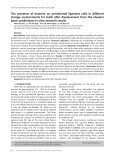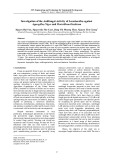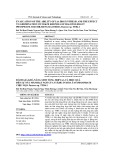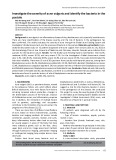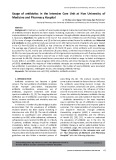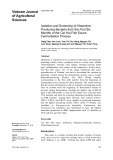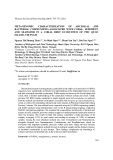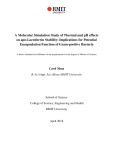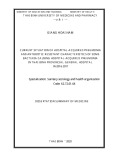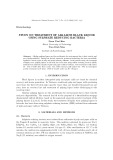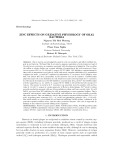A novel gene, fad49, plays a crucial role in the immediate early stage of adipocyte differentiation via involvement in mitotic clonal expansion Tomoaki Hishida, Tsuyoshi Eguchi, Shigehiro Osada, Makoto Nishizuka and Masayoshi Imagawa
Department of Molecular Biology, Graduate School of Pharmaceutical Sciences, Nagoya City University, Aichi, Japan
Keywords 3T3-L1 cell; adipocyte differentiation; CCAAT ⁄ enhancer-binding protein; obesity; peroxisome proliferator-activated receptor c
Correspondence M. Imagawa, Department of Molecular Biology, Graduate School of Pharmaceutical Sciences, Nagoya City University, 3-1 Tanabe-dori, Mizuho-ku, Nagoya, Aichi 467- 8603, Japan Fax: +81 52 836 3455 Tel: +81 52 836 3455 E-mail: imagawa@phar.nagoya-cu.ac.jp
(Received 24 July 2008, revised 7 September 2008, accepted 11 September 2008)
doi:10.1111/j.1742-4658.2008.06682.x
Adipogenesis is accomplished via a complex series of steps, and the events at the earliest stage remain to be elucidated. To clarify the molecular mech- anisms of adipocyte differentiation, we previously isolated 102 genes expressed early in mouse 3T3-L1 preadipocyte cells using a PCR subtrac- tion system. About half of the genes isolated appeared to be unknown. After isolating full-length cDNAs of the unknown genes, one of them, named factor for adipocyte differentiation 49 (fad49), appeared to be a novel gene, as the sequence of this clone showed no identity to known genes. FAD49 contains a phox homology (PX) domain and four Src homology 3 (SH3) domains, suggesting that it may be a novel scaffold protein. We found that the PX domain of FAD49 not only has affinity for phosphoi- nositides, but also binds to its third SH3 domain. Expression of fad49 was transiently elevated 3 h after differentiation was induced, and diminished 24 h after induction. Induction of the fad49 gene was observed in adipocyte differentiable 3T3-L1 cells, but not in non-adipogenic NIH-3T3 cells. RNAi-mediated knockdown of fad49 significantly impaired adipocyte dif- ferentiation. Moreover, the knockdown of fad49 by RNAi inhibited mitotic clonal expansion, and reduced the expression of CCAAT ⁄ enhancer-binding protein b (C ⁄ EBPb) and C ⁄ EBPd at the immediate early phase. Taken together, these results show that fad49, a novel gene, plays a crucial role in the immediate early stage of adipogenesis.
dysregulated production of hormones and cytokines by adipose tissue, such as tumor necrosis factor a, adipo- nectin and resistin, which leads to various diseases, such as type 2 diabetes, stroke and cardiac infarction [3–6].
Obesity is a serious and growing health problem that is a key risk factor in several obesity-related diseases, such as type 2 diabetes, hypertension, hyperlipidemia and cardiac infarction [1–3]. Obesity may occur through excessive accumulation of white adipose tissue (WAT), composed mainly of adipocytes, which play an important role in the storage of energy and secretion of a variety of hormones and cytokines that regulate metabolic activities in the body [1]. Such pathological in accumulation of WAT in the body
results
Obesity, the pathological development of adipose tis- sue, results from an increase in the cell size of individ- ual adipocytes and an increase in total adipocyte cell numbers through differentiation of preadipocytes in in adipose tissue into mature adipocytes. Therefore,
Abbreviations aP2, adipocyte lipid-binding protein; C ⁄ EBP, CCAAT ⁄ enhancer-binding protein; DAPI, 4¢,6-diamidino-2-phenylindole; DMEM, Dulbecco’s modified Eagle’s medium; fad, factor for adipocyte differentiation; FBS, fetal bovine serum; GST, glutathione S-transferase; IBMX, 3-isobutyl-1- methylxanthine; MCE, mitotic clonal expansion; PI(3)P, phosphatidylinositol 3-phosphate; PI(3,4)P2, phosphatidylinositol 3,4-bisphosphate; PI(4)P, phosphatidylinositol 4-phosphate; PI(4,5)P2, phosphatidylinositol 4,5-bisphosphate; PI(5)P, phosphatidylinositol 5-phosphate; PPARc, peroxisome proliferator-activated receptor c; PX, phox homology; SH3, Src homology 3; shRNA, short hairpin RNA; SREB-1, sterol regulatory element-binding protein-1; WAT, white adipose tissue.
FEBS Journal 275 (2008) 5576–5588 ª 2008 The Authors Journal compilation ª 2008 FEBS
5576
T. Hishida et al.
fad49 plays a crucial role in adipogenesis
the context of the prevention and treatment of obesity- related diseases, it is important to elucidate the mecha- nisms of adipocyte differentiation, as well as adipocyte enlargement.
differentiation. FAD49 contains a phox homology (PX) domain, which has affinity for phosphoinositides, and four Src homology 3 (SH3) domains, which bind to polyproline PXXP ligands, suggesting that FAD49 is a novel scaffold protein. RNAi experiments demon- strated that fad49 is crucial in adipogenesis, and that it plays important roles in events early in the differentia- tion process, including MCE and the induction of C ⁄ EBPb and C ⁄ EBPd genes. Taken together, these results imply that fad49, encoding a novel scaffolding protein, plays an important role in the immediate early stage of adipocyte differentiation.
Results
Cloning of full-length mouse fad49 cDNA
Much knowledge of adipogenesis has derived from studies using mouse 3T3-L1 cells as model cells of adipocyte differentiation. 3T3-L1 cells are grown to con- fluence and growth arrested. Growth-arrested 3T3-L1 cells differentiate into mature adipocytes after the addi- tion of insulin, 3-isobutyl-1-methylxanthine (IBMX), dexamethasone and fetal bovine serum (FBS) [7–9]. After they treatment with the induction cocktail, undergo approximately two cycles of synchronized cell division, a process known as mitotic clonal expansion (MCE) [10,11]. MCE is a requisite step for adipocyte differentiation, followed by terminal differentiation, in which peroxisome proliferator-activated receptor c (PPARc) and CCAAT ⁄ enhancer-binding protein a (C ⁄ EBPa) play important roles as master regulators [12]. In terminal differentiation, PPARc and C ⁄ EBPa transactivate each other and upregulate the expression of many adipogenic genes, causing the cells to acquire an adipogenic phenotype.
consensus
sequence
for
Expression of these transcriptional factors starts to increase in the middle stage of adipocyte differentia- tion, partly through transactivation of C ⁄ EBPb and C ⁄ EBPd, the expression of which is immediately upreg- ulated after hormonal induction [13,14]. Several other factors that are involved in regulating the expression and transcriptional activity of PPARc and C ⁄ EBPa have been identified by other studies [15]. Therefore, events in the middle and late stage of adipocyte differ- entiation have been studied relatively thoroughly. In contrast, the overall mechanisms of events in the early stage of including the differentiation programme, MCE and induction of the C ⁄ EBPb and C ⁄ EBPd genes, remain to be elucidated.
accession
amino
acids
Using the PCR subtraction method, we originally isolated fad49 as one of many unknown genes the expression of which was elevated at 3 h after induction of adipocyte differentiation. The PCR-subtraction method used in the previous study gave cDNA frag- ments only 300–900 bp long because the amplified frag- ments were digested using RsaI for non-bias cloning [16]. The length of fad49 was 870 bp. Therefore, we attempted to isolate a full-length cDNA of fad49 using 5¢ and 3¢ RACE methods, and expressed sequence tag (EST)-walk method, which is a combination method of predicting exons of interest in genes, utilizing the mouse genome and EST followed by RT-PCR (Fig. 1A). 5¢ and 3¢ RACE were performed using cDNA prepared from 3T3-L1 cells 3 h after induction. As a result, a 1109 bp cDNA fragment containing an initiation codon at 6 bp was isolated by 5¢ RACE. The sequence (GCCATGC) including initiation codon is close to the translation initiation (A/GCCATGA/G). A 1809 bp cDNA fragment con- taining a stop codon was isolated by RT-PCR. A 1007 bp cDNA containing a poly(A) tail was obtained by 3¢ RACE. By combining these cDNA fragments, fad49 was found to consist of 7258 bp with an ORF of 910 number (GenBank AB430861). Because blast database searches identified no significant matches against proteins of known func- tion, fad49 appears to be a novel gene.
the mouse
genome database
In order to clarify the molecular mechanisms in the early phase of adipocyte differentiation, we previously isolated 102 genes for which expression early in the differentiation process was induced using a PCR sub- traction system [16,17]. These genes included transcrip- tion factors and signaling molecules [17–19]. About half of them were unknown genes, whose functions remain unclear. As the fragments obtained by PCR subtraction are small, we needed to isolate the full- length cDNAs of the unknown genes. We have previ- ously revealed that several of them are novel genes, such as factor for adipocyte differentiation (fad) 24, fad104 and fad158, which play crucial roles in adipo- genesis [20–23].
Here, we report the isolation of another novel gene, fad49, and the close involvement of fad49 in adipocyte
We next analyzed the genomic distribution of fad49 (http://www. using ncbi.nlm.nih.gov/genome/seq/BlastGen/BlastGen.cgi? taxid=10090), which was made public by the Mouse Genome Sequencing Consortium. The result indicated that fad49 exists at locus 11A4 of mouse chromo- some 11 and consists of 13 exons divided by 12 introns (Fig. 1B). Sequencing of the exon ⁄ intron junctions in
FEBS Journal 275 (2008) 5576–5588 ª 2008 The Authors Journal compilation ª 2008 FEBS
5577
T. Hishida et al.
fad49 plays a crucial role in adipogenesis
AB430862). A blast search of the human genome database revealed a human homolog of fad49 on chro- mosome 5 at locus 5q35. The protein encoded by human fad49 also contained a PX domain and four SH3 domains. A comparison of the human and mouse FAD49 showed 87.1% conservation at the full-length protein level, and more than 96% at the domain level (Fig. 2B).
Characterization of the PX domain of FAD49
Fig. 1. Cloning and genomic structures of mouse fad49. (A) The full- length cDNA for mouse fad49 was isolated by RT-PCR, 5¢ and 3¢ RACE. ‘S’ is the fragment obtained by the original PCR-subtraction method. ‘RT’, ‘5¢-R’ and ‘3¢-R’ are fragments obtained by RT-PCR, 5¢ RACE and 3¢ RACE, respectively. The combined sequence is shown as fad49. The initiation and stop codon are also indicated. The deduced amino acid sequence revealed a 910 amino acid protein for mouse FAD49. (B) Schematic representation of the mouse fad49 gene structure. The thirteen exons of the fad49 gene on chromo- some 11 are represented by vertical bars in the top part of the figure. The size of each exon is indicated in the bottom panel.
the database revealed that the GT ⁄ AG rule was main- tained in all cases (data not shown).
The deduced protein primary structure of mouse and human fad49
The PX domain has been reported to be implicated in highly diverse functions, such as cell signaling, vesicular trafficking and protein sorting [24–30]. Recent studies have demonstrated that PX domains are important phosphoinositide-binding modules with varying lipid- binding specifities, although specificity for phosphati- dylinositol 3-phosphate [PI(3)P] appears to be the most common [28,31–34]. For example, the PX domain of p40phox interacts with PI(3)P, the PX domains of p47phox and Fish, which contains five SH3 domains and a PX domain, binds to PI(3,4)P2 [24,27], and the PX domain of C2 containing Ptdlns kinase (CPK) class of PI 3-kinase selectively binds to PI(4,5)P2 [32]. Moreover, the conserved polyproline motif (PXXP) in many PX domains suggests that it may act as a target for SH3 domains. In fact, it has been reported that the PX domain of p47phox binds intramolecularly to the SH3 domain in the same protein, and that this intramolecu- lar interaction suppresses the lipid-binding activity of the PX domain in the resting state; phosphorylation of p47phox releases the binding, resulting in the active state, i.e. open conformation [25,35,36].
The ORF of fad49 encodes a putative protein of 910 amino acids that contains a PX domain (solid underlin- ing) and four SH3 domains (dotted underlining) (Fig. 2A). Moreover, the encoded protein also con- tained ten polyprolines (boxed), which could be possible ligands for the SH3 domain. Thus, fad49 encodes a pro- tein containing many protein-binding domains, suggest- ing that this protein may be a novel scaffold protein.
As FAD49 contains a PX domain as described above, we determined whether the FAD49 PX domain could bind to phosphoinositides. To test whether the FAD49 PX domain has affinity for phosphoinositides, we bacte- rially expressed the FAD49 PX domain fused to gluta- thione S-transferase (GST–PX) and used GST protein (GST) as a negative control. Lipid binding was then measured using overlay blotting as described in Experi- mental procedures. As shown in Fig. 3A, GST–PX bound most strongly to PI(3,5)P2, and to a lesser extent to PI(3)P, PI(4)P and PI(5)P, but no binding to any of the lipid species was observed for GST as a control.
the resultant
fragments,
We next tried to isolate the full-length ORF of human fad49. We first used the human genome data- base to predict the ORF region of human fad49 by splicing out the introns and combining the exons of the ORF of human fad49. To isolate human fad49 including the entire ORF, we next constructed primer sets as described in Experimental procedures, and per- formed RT-PCR using template cDNA prepared from mRNA extracted from HeLa cells. From sequence the full-length analyses of cDNA of human fad49 comprised a 2733 bp ORF encoding 911 amino acids (GenBank accession number
The PXXP motif was found in the FAD49 PX domain, as in many PX domains, suggesting that the PX domain could bind to an SH3 domain of FAD49. To test whether the PX domain could interact with an SH3 domain in FAD49, we performed in vitro binding assays using various bacterially expressed proteins: individual GST–PX and FLAG fusion proteins of the PX SH3 domains of FAD49. We found that
FEBS Journal 275 (2008) 5576–5588 ª 2008 The Authors Journal compilation ª 2008 FEBS
5578
T. Hishida et al.
fad49 plays a crucial role in adipogenesis
Fig. 2. Amino acid sequence and domain structure of FAD49. (A) Amino acid sequence of mouse FAD49. The PX domain is underlined by a solid line and the four SH3 domains are underlined by dotted lines. Ten polyproline motifs that represent poten- tial SH3 binding sites are boxed. (B) Sche- matic structure of mouse and human FAD49. The PX domain and four SH3 domains are highly conserved between mice and humans.
domain of FAD49 can interact with its third SH3 domain (Fig. 3B).
Subcellular localization of FAD49
The truncated mutant GFP–PX, which only contains the PX domain of FAD49, was found in punctate structures in the nuclei as well as in the cytoplasm. The other truncated mutant, GFP–SH3, which does not contain the PX domain, was localized in punctate structures that seem to differ from those in which GFP–PX was found. These results suggest that the PX and SH3 domains of FAD49 play a role in the localization of FAD49.
Expression profiles of fad49 in differentiating and non-differentiating cells and tissue distribution
To further characterize fad49, the subcellular localiza- tion of FAD49 was determined by transient transfec- tion of an N-terminally Myc-tagged full-length FAD49 (Myc–FAD49) expression plasmid into 3T3- L1 cells. Cells were immunostained using monoclonal anti-Myc IgG1. As shown in Fig. 4A, Myc–FAD49 was found predominantly in the cytoplasm. The same result was obtained using a C-terminally Myc-tagged FAD49 (FAD49–Myc) expression plasmid. To exam- the FAD49 PX domain or SH3 ine the role of domains on the subcellular localization of FAD49, we next determined the subcellular localization of GFP proteins fused to full-length FAD49 (GFP–FL), the PX domain (GFP–PX) and FAD49 lacking its PX domain (GFP–SH3) (Fig. 4B,C). GFP–FL was mostly detected in the cytoplasm, consistent with Fig. 4A.
To investigate the role of fad49 during adipocyte dif- ferentiation, we first determined the mRNA expression fad49 by Northern blotting. To monitor levels of changes in the levels of fad49 during adipocyte differ- entiation, 3T3-L1 cells were stimulated with an induc- tion cocktail, and then total RNA was prepared at various time points. The expression of fad49 increased quickly after differentiation was induced, reaching a
FEBS Journal 275 (2008) 5576–5588 ª 2008 The Authors Journal compilation ª 2008 FEBS
5579
T. Hishida et al.
fad49 plays a crucial role in adipogenesis
Fig. 3. Characterization of the PX domain of FAD49. (A) Phospho- inositide binding specificity of the PX domain of FAD49. Bacterially expressed GST or GST–PX were incubated with PIP arrays pre- spotted with the indicated phosphpoinositide (100, 50, 25, 12.5, 6.25, 3.13, 1.56 pmol). The membranes were washed and the GST fusion proteins bound to the membrane were detected using anti- GST serum. (B) Interaction of the FAD49 PX domain with its third SH3 domain. FLAG–SH3 proteins (10 pmol) were tested in co-pre- cipitation experiments with GST–PX or GST as a control (1 lg). The co-precipitating samples were subject to SDS–PAGE and detected by Western blotting.
maximum at 3 h, and then decreased to 12 h (Fig. 5A). This result indicates that fad49 is transiently expressed in the early phase of adipocyte differentiation.
Fig. 4. Subcellular localization of FAD49. (A) 3T3-L1 cells transiently transfected with the Myc–FAD49 or FAD49–Myc expression plas- mid were fixed and blocked for immunofluorescence staining with anti-Myc serum. (B) Schematic representation of GFP fusion pro- teins for each FAD49 deletion mutant used in this study. (C) Sub- cellular localization of EGFP–FAD49 fusion proteins. 3T3-L1 cells were transiently transfected with an EGFP–FAD49-expressing plas- mid or empty vector. One day after transfection, the cells were fixed and stained with DAPI. EGFP signals were detected using a fluorescence microscope.
To investigate the tissue distribution of fad49, we determined the expression levels of fad49 by quantita- tive PCR in various tissues isolated from adult male mice, including WAT and brown adipose tissue (BAT) (Fig. 5C). WAT samples were separated into two frac- tions: the stromal–vascular fraction enriched with prea- dipocytes and the mature adipocyte fraction. Tissue distribution studies revealed that high expression of
We next determined whether or not fad49 expression was restricted to cells in a state of differentiation. 3T3- L1 cells differentiate to mature adipocytes when stimu- lated with adipogenic inducers 2 days after reaching a state of confluence, whereas proliferating 3T3-L1 cells do not differentiate into adipocytes even in the pres- ence of inducers. Another mouse fibroblastic cell line, NIH-3T3, does not differentiate into adipocytes in either a postconfluent or proliferating state. These two cell lines were treated with inducers in a postconfluent (growth-arrested) or proliferating state. Total RNA was prepared from these cells before or 3 h after dif- ferentiation was induced and subjected to quantitative PCR, which showed that marked induction only occurred in growth-arrested 3T3-L1 cells, suggesting that the elevation in expression of fad49 is restricted to the adipocyte differentiable state (Fig. 5B). This result strongly suggests that fad49 plays a functional role in adipogenesis.
FEBS Journal 275 (2008) 5576–5588 ª 2008 The Authors Journal compilation ª 2008 FEBS
5580
T. Hishida et al.
fad49 plays a crucial role in adipogenesis
Fig. 5. Expression profiles of fad49 in differ- entiating and non-differentiating cells and tissue distribution. (A) Time course of fad49 mRNA expression in the early stage of adipo- cyte differentiation. Total RNA prepared from 3T3-L1 cells at various time points after treat- ment with inducers was loaded (20 lg) in each column. Staining with ethidium bromide (EtBr) for ribosomal RNA is shown as a load- ing control. (B) Expression profile of fad49 in the adipocyte differentiating and non-differ- entiating cells. Total RNA isolated from growth-arrested and proliferating 3T3-L1 and NIH-3T3 cells before and 3 h after induction was subjected to quantitative PCR. Each column represents the mean ± SD (n = 3). (C) Distribution of fad49 mRNA in various tissues. The expression level of fad49 in various tissues isolated from C57B1 ⁄ 6J mice was determined by quantitative PCR, and normalized to 18S rRNA expression deter- mined by quantitative PCR. Each column represents the mean ± SD (n = 3).
fad49 was observed in the stromal–vascular fraction of WAT, and moderate expression was detected in heart, skeletal muscle and the mature adipocyte fraction of WAT. Thus, the expression of fad49 in the stromal– vascular fraction was higher than that in mature adipocytes, suggesting that expression of fad49 is pre- dominant in preadipocytes. As expression of fad49 was observed in skeletal muscle, we analyzed the expression levels of fad49 during the myogenesis of mouse C2C12 cells. Expression of fad49 was weak, and the level was unchanged during myogenesis of C2C12 cells (data not shown).
the expression of fad49 during adipogenesis. For the RNAi experiments, two short hairpin RNA (shRNA) expression plasmids named shfad49-1 and shfad49-2 were constructed to target regions 1 and 2, respectively (as defined in Experimental procedures), in the ORF of the fad49 gene. Each of the shRNA expression plas- mids was transfected into 3T3-L1 cells. Three hours after total induction for adipocyte differentiation, RNA was isolated, and the expression levels of fad49 were determined by quantitative PCR. We found that shfad49-2 had a strong silencing effect on fad49 expression, while the effect of shfad49-1 was milder (Fig. 6A). Therefore, we used shfad49-2 to perform the RNAi experiments.
Effect of fad49 knockdown on differentiation of 3T3-L1 cells into adipocytes
As described above, the expression of mouse fad49 is rapidly upregulated early in the differentiation of 3T3- L1 cells into adipocytes, and seems to play a role in adipogenesis. To characterize the function of this gene during adipogenesis, we performed RNAi to silence
Next, we determined the expression levels of fad49 by quantitative PCR in the cells transfected with shfad49-2 at each time point after induction of differ- entiation. We confirmed that RNAi treatment reduced fad49 mRNA levels (Fig. 6B). After 8 days, the cells were fixed and stained with Oil red O and the amounts triacylglycerol were determined. The number of of
FEBS Journal 275 (2008) 5576–5588 ª 2008 The Authors Journal compilation ª 2008 FEBS
5581
T. Hishida et al.
fad49 plays a crucial role in adipogenesis
Fig. 6. Effect of fad49 knockdown by RNAi on adipocyte differentiation. (A) The effects of two different shRNAs on the expression of fad49. Total RNA, obtained from 3T3-L1 cells transfected with shfad49-1, shfad49-2 or the scrambled shRNA expression plasmid as a control at 3 h after differentiation induction, was subjected to quantitative PCR. The expression level of fad49 was normalized to 18S rRNA expres- sion. Each column represents the mean ± SD (n = 3). (B) fad49 expression in fad49 knockdown 3T3-L1 cells was determined by quantitative PCR. Total RNA obtained from 3T3-L1 cells transfected with shfad49-2 (open bars) or with the scrambled shRNA expression plasmid as a control (solid bars) at each time point was subjected to quantitative PCR. The expression level was normalized to 18S rRNA expression. Each column represents the mean ± SD (n = 3). (C) Adipocyte differentiation of fad49 knockdown 3T3-L1 cells. The cells transfected with shfad49-2 or the scrambled shRNA expression plasmid as a control were stimulated with inducers. After 8 days, the cells were stained with Oil red O to detect oil droplets. The amount of triglyceride measured in fad49 knockdown cells (open bars) or control cells (solid bars) 8 days after the induction is also shown. Each column represents the mean ± SD (n = 3). **P < 0.01 versus control. (D) Effect of fad49 RNAi treat- ment on the expression of various adipogenic genes. Total RNA obtained from fad49 knockdown cells (open bars) or control cells (solid bars) at each time point was subjected to quantitative PCR, and normalized to 18S rRNA expression determined by quantitative PCR. Each column represents the mean ± SD (n = 3). *P < 0.05 and **P < 0.01 versus control. (E) Effect of fad49 RNAi treatment on the expression of C ⁄ EBPb and C ⁄ EBPd in the immediate early stage of adipogenesis. Total RNA obtained from fad49 knockdown cells (open bars) or control cells (solid bars) at each time point was subjected to quantitative PCR. Expression levels were normalized to 18S rRNA expression deter- mined by quantitative PCR. Each column represents the mean ± SD (n = 3). *P < 0.05 and **P < 0.01 versus control. (F) Effect of fad49 RNAi treatment on MCE. The cells transfected with shfad49-2 (fad49 KD) or the scrambled shRNA expression plasmid as a control were stimulated with inducers. Parallel cultures of fad49 knockdown cells or control cells were harvested on the indicated days after differentia- tion had been induced. Cell numbers were determined by taking counts with a hemocytometer. Each column represents the mean ± SD (n = 4). **P < 0.01 versus control.
FEBS Journal 275 (2008) 5576–5588 ª 2008 The Authors Journal compilation ª 2008 FEBS
5582
T. Hishida et al.
fad49 plays a crucial role in adipogenesis
by
genes
the full-length cDNA of a novel gene, named fad49, which showed no identity to known genes. Isolation of the full-length ORFs of mouse and human fad49 revealed that the protein encoded by fad49 has a PX domain, four SH3 domains and several PXXP motifs, suggesting that FAD49 may be a novel scaffold protein.
indicating
traffic
signaling and membrane
fad49 RNAi
treatment
The PX domain, described as a phosphpoinositide- binding module, was first identified in p40phox and p47phox, two cytosolic subunits of NADPH oxidase, and has been found since in a variety of proteins involved in cell [27,28,30,39]. Several studies have demonstrated that PX domains play important roles in the function of proteins contain- ing this domain [40]. In particular, p47phox, which con- tains the PX domain and two SH3 domains, has been intensely studied. In unstimulated neutrophils, p47phox shows an intramolecular interaction between its PX domain and the second SH3 domain, preventing membrane association. Stimulation of neutrophils results in release of the inhibitory intramolecular inter- action, allowing its PX domain to associate with the membrane by binding to lipids [25,35,36].
Oil red O-stained cells and the accumulation of triacyl- glycerol were significantly reduced in the RNAi-treated cells (Fig. 6C). An inhibitory effect of knockdown of fad49 on adipocyte differentiation was also observed in RNAi experiments performed with shfad49-1 (data not shown). Next, we determined the expression levels of adipogenic marker quantitative PCR (Fig. 6D). The levels of PPARc, C ⁄ EBPa, adipocyte lipid-binding protein (aP2) and sterol regulatory ele- ment-binding protein-1 (SREBP-1) decreased in fad49 knockdown cells, that RNAi-mediated knockdown of fad49 inhibits adipocyte differentiation of 3T3-L1 cells. The levels of C ⁄ EBPb and C ⁄ EBPd were altered in fad49 knockdown cells compared to control cells transfected with scrambled shRNA. As C ⁄ EBPb and C ⁄ EBPd were dramatically expressed early in adipogenesis, we determined the expression levels of C ⁄ EBPb and C ⁄ EBPd in fad49 knockdown cells at 0–6 h after the differentiation was induced. Interestingly, significantly reduced the levels of C ⁄ EBPd and partially reduced those of C ⁄ EBPb (Fig. 6E). These results imply that fad49 is crucial in the immediate early stage of adipocyte differentiation.
In order to examine the functional role of the FAD49 PX domain, we characterized its PX domain. Lipid binding studies and in vitro binding studies showed that the PX domain of FAD49 has affinity for PI(3)P, PI(4)P, PI(5)P and PI(3,5)P2, and interacts with the third SH3 domain. Thus, binding of the FAD49 PX domain to phosphoinositides might be regulated by the interaction between the PX domain and the third SH3 domain, as in p47phox, although whether the interaction of the PX domain with the third SH3 domain is intra- or intermolecular remains to be established.
As fad49 appears to play an important role in the early stages of adipocyte differentiation, we focused on MCE, which is synchronous transient cell growth that can be observed after postconfluent 3T3-L1 cells have been treated with an optimal mixture of adipogenic stimulants [10,37]. It has been reported that this phase is required for adipocyte differentiation [38]. To eluci- date the role of fad49 in MCE, we determined the effect of fad49 RNAi treatment on MCE (Fig. 6F). The effect on MCE was quantified by determining the cell count using a hemocytometer at 1-day intervals throughout the differentiation program. Cell numbers in control cultures increased 3.1-fold between days 0 and 4, and remained constant between days 4 and 5. In comparison, cell numbers in fad49 knockdown cultures only increased 2.2-fold by day 4. This result indicates that fad49 plays an important role in MCE during adipogenesis.
Discussion
To further characterize fad49, we examined the sub- cellular localization of FAD49. Subcellular localization studies showed that it is found in the cytoplasm, and that the PX domain and SH3 domains are important in FAD49 localization. Two deletion mutants, GFP– PX and GFP–SH3, localized to punctate structures, while GFP–FL was diffusely cytoplasmic, suggesting that, in the context of the full-length protein, the PX domain and SH3 domains of FAD49 might not be able to contact lipids and ⁄ or protein targets due to interaction between them. We are now investigating the role of this interaction on FAD49 localization. Although we tested whether the inducers for adipocyte differentiation induce a change in the distribution of FAD49, we did not observe any changes in FAD49 localization after induction.
To elucidate the molecular mechanisms of adipocyte differentiation, we previously used PCR subtraction to isolate 102 genes that were induced 3 h after differenti- ation was induced [16,17]. About half of them were unknown genes. As a result of attempts to isolate full- length cDNAs for the unknown genes, we previously isolated several novel genes that are crucial for adipo- cyte differentiation [20–22]. In this study, we cloned
In this study, we also demonstrated an important role of fad49 in adipocyte differentiation. The expres- sion of fad49 was transiently upregulated 3 h after
FEBS Journal 275 (2008) 5576–5588 ª 2008 The Authors Journal compilation ª 2008 FEBS
5583
T. Hishida et al.
fad49 plays a crucial role in adipogenesis
RNA isolation, real-time quantitative RT-PCR and northern blotting
Total RNA was extracted using TRIzol (Invitrogen, Carls- bad, CA, USA) according to the manufacturer’s instructions. The total RNA was converted to single-stranded cDNA using a random primer and ReverTra Ace (Toyobo, Osaka, Japan). The cDNA was used as a template for quantitative PCR. An ABI PRISM 7000 sequence detection system (Applied Biosystems, Foster City, CA, USA) was used to perform the quantitative PCR. The pre-designed primers and probe sets for fad49, aP2, PPARc, C ⁄ EBPa, C ⁄ EBPb, C ⁄ EBPd, SREBP-1 and 18S rRNA were obtained from Applied Biosystems. The reaction mixture was prepared using a TaqMan Universal PCR Master Mix (Applied Bio- systems) according to the manufacturer’s instructions. The mixture was incubated at 50 (cid:3)C for 2 min and at 95 (cid:3)C for 10 min, and then PCR was performed at 95 (cid:3)C for 15 s and at 60 (cid:3)C for 1 min for 40 cycles. Relative standard curves were generated in each experiment to calculate the input amounts for the unknown samples. Northern blotting was performed as described previously [22].
exposure to an induction cocktail, and this upregula- tion was restricted to the adipocyte differentiable state. Moreover, RNAi experiments demonstrated that fad49 is closely involved in adipocyte differentiation. Inter- estingly, fad49 is involved in the induction of C ⁄ EBPb and C ⁄ EBPd genes. Although the cAMP response element-binding protein has been reported to regulate the expression of C ⁄ EBPb and C ⁄ EBPd in the early the overall stages of adipocyte differentiation [41], mechanisms regulating C ⁄ EBPb and C ⁄ EBPd expres- sion remain to be elucidated. In this regard, further studies of the molecular function of fad49 should pro- vide new insights into the regulation of C ⁄ EBPb and C ⁄ EBPd expression early in adipocyte differentiation. fad49 In addition, RNAi-mediated knockdown of resulted in significant inhibition of cell growth after differentiation was induced, suggesting that fad49 is crucial in MCE. As MCE is synchronous transient cell growth and is required for adipocyte differentiation, the effect of FAD49 on MCE may be critical for adipogenesis.
Cloning of the full-length cDNA of mouse fad49
Although little is known about the molecular mecha- nism for regulation of MCE, C ⁄ EBPb and mitogen- activated protein kinase are likely to play important roles in MCE [12,38]. In addition, we found that C ⁄ EBPd is also required for MCE (unpublished data). As fad49 RNAi treatment results in reduction of C ⁄ EBPb and C ⁄ EBPd expression, we speculate that fad49 is involved in MCE, partly through its contribu- tion to the induction of C ⁄ EBPb and C ⁄ EBPd genes. Further analysis of fad49 will give new insight into the signaling pathway in the immediate early stage of adipocyte differentiation.
Experimental procedures
Materials
primers:
Dexamethasone, insulin and 4¢,6-diamidino-2-phenylindole (DAPI) were purchased from Sigma (St Louis, MO, USA). IBMX was purchased from Nacalai Tesque (Kyoto, Japan). Dulbecco’s modified Eagle’s medium (DMEM) was pur- chased from NISSUI Pharmaceutical (Tokyo, Japan). PIP arrays(cid:2) were purchased from Echelon Biosciences (Salt Lake City, UT, USA).
Antibodies
5¢-CATGAGATGACCCAGCT-3¢
FEBS Journal 275 (2008) 5576–5588 ª 2008 The Authors Journal compilation ª 2008 FEBS
5584
To isolate the full-length cDNA of mouse fad49, 5¢ and 3¢ RACE and RT-PCR were performed. 5¢ and 3¢ RACE were performed using a Marathon cDNA amplification kit (BD Biosciences Clontech) according to the manufacturer’s instructions. Total RNA was prepared from 3T3-L1 cells 3 h after induction. mRNA was isolated from total RNA using Oligotex-dT30 (Daiichi Pure Chemicals, Tokyo, Japan) according to the manufacturer’s instructions. First- strand cDNA was amplified using the oligo(dT) primer and avian myeloblastosis virus reverse transcriptase (Clontech). The second strand was synthesized using a second-strand enzyme mixture containing RNase H, Escherichia coli DNA polymerase 1 and E. coli DNA ligase. PCR for 5¢ RACE was performed using the AP1 primer (5¢-CCATCCTAAT ACGACTCACTATAGGGC-3¢) and one of three fad49- specific 5¢-GCCTGTGAGCGCCTAGCATGG TTC-3¢, 5¢-GGATTCCTGCAGAGCGTGGGTGTGG-3¢ and 5¢-CCTGGGGTGGGATGGGGGGCTTCGGCAG-3¢ for 5¢-R-1, 5¢-R-2 and 5¢-R-3, respectively. PCR for 3¢ RACE was performed using the AP1 primer and an fad49-specific primer (5¢-GGCCATCTCGGCCCCTTCGC GTGGC-3¢). RT-PCR was performed using total RNA pre- pared from 3T3-L1 cells 3 h after induction. PCRs were per- (Toyobo) with fad49-specific formed using KOD plus forward primer and reverse primer 5¢-GCTTCTGGTAACATGG-3¢ for P-1, and fad49-specific forward primer 5¢-TGTTGGACAAGTTCCC CAT-3¢ and reverse primer 5¢-GCGGCTCCATCTTCTGTC TTTCCC-3¢ for P-2. The fragments obtained from RT-PCR, 5¢ RACE and 3¢ RACE were subcloned into pBluescript The following antibodies were obtained commercially: monoclonal anti-FLAG M2 IgG1 (Sigma) and anti-c-Myc IgG1 (BD Biosciences Clontech, Palo Alto, CA, USA), and polyclonal anti-GST IgG (Amersham Biosciences, Piscataway, NJ, USA).
T. Hishida et al.
fad49 plays a crucial role in adipogenesis
(Amersham Biosciences) and FLAG M2 beads (Sigma), according to the manufacturer’s instructions. KS+ (Stratagene, Agilent Technologies, Santa Clara, CA, USA) and analyzed by DNA sequencing as described below.
Cloning of the full-length cDNA of human fad49
Phospholipid binding
Lipid binding studies were performed using PIP arrays(cid:2) (Echelon Biosciences) according to the manufacturer’s instructions.
In vitro binding assay
First, we predicted the full-length ORF of human fad49 using the human genome sequence and the full-length ORF of mouse fad49. Next, based on the predicted sequence for human fad49, RT-PCR was performed as described above using total RNA prepared from HeLa cells. The 5¢ region of the human cDNA of fad49 was amplified using KOD - plus (Toyobo) with a human fad49-specific forward primer (5¢-GCGGCCATGCCGCCGCGGCGCAGCATCG-3¢) and reverse primer (5¢-TTTCTCGATCACCTCGAC-3¢). In the same way, the 3¢ region of the human cDNA of fad49 was amplified with a human fad49-specific forward primer (5¢-ACATGACCATTCCTCGAG-3¢) and reverse primer (5¢-TCTAGGCAGAAAGGGAGT-3¢). As both the ampli- fied 5¢ and 3¢ regions harbor the EcoRI site, the fragments obtained from RT-PCR were digested with EcoRI, purified, subcloned into the HincII ⁄ EcoRI site of pBluescript KS+ and analyzed by DNA sequencing as described below.
Plasmid construction
For in vitro binding experiments, glutathione–Sepharose- bound proteins, GST or GST–PX, were prepared, and then incubated with each of the purified FLAG fusion proteins for individual SH3 domains of FAD49 in GST-binding buf- fer [20 mm Tris ⁄ HCl pH 8.0, 180 mm KCl, 0.2 mm EDTA, 0.5% w ⁄ v Nonidet P-40 (Nacalai Tesque)] overnight at 4 (cid:3)C. Samples were washed three times in GST wash buffer (20 mm Tris ⁄ HCl pH 8.0, 180 mm KCl, 0.2 mm EDTA, 1% Nonidet P-40), eluted from the resin by boiling in an SDS sample buffer (62.5 mm Tris ⁄ HCl pH 6.8, 10% v ⁄ v glycerol, 2% w ⁄ v SDS, 5% v ⁄ v b-mercaptoethanol, 0.01% w ⁄ v bromophenol blue), subjected to SDS–PAGE and transferred to poly(vinylidene difluoride) membranes. Fol- lowing transfer, membranes were blocked with 4% w ⁄ v skim milk in Tris-buffered saline with 0.1% Tween-20 (TBS-T), and probed using primary antibodies, secondary antibodies, conjugated horseradish peroxidase and an enhanced chemiluminescence detection kit (GE Healthcare, Chalfont St Giles, UK) to detect specific proteins.
subcloned into the pGEX4T-1
DNA sequencing and database analyses
The sequence was determined using a DSQ 1000 automated sequencer (Shimadzu Corp., Kyoto, Japan) and an ABI PRISM 3100 genetic analyzer (Applied Biosystems). The search for a human ortholog in human genome databases was performed using blast programs accessed via the National Center for Biotechnology Information (NCBI) homepage.
Cell culture, differentiation and cell counts
The DNA fragments encoding fad49 were amplified by RT-PCR from total RNA extracted from 3T3-L1 cells 3 h after differentiation induction. The resulting fragments were cloned, using appropriate restriction sites, in-frame into several expression vectors as described below. Fragments encoding the PX domain and individual SH3 domains of FAD49 were vector (Amersham Pharmacia Biotech, Piscataway, NJ, USA) and pFLAG-MAC vectors (Sigma), respectively. For N-termi- nally Myc-tagged FAD49 (Myc–FAD49), the DNA frag- ment encoding full-length FAD49 was subcloned into the pCMV-Myc vector (BD Biosciences Clontech). For C-terminally Myc-tagged FAD49 (FAD49–Myc), the DNA fragment that encodes full-length FAD49 followed by the Myc tag sequence and stop codon was subcloned into pEGFP-N3 (BD Biosciences Clontech). For three constructs, full-length FAD49 (GFP–FL), the FAD49 PX domain (GFP–PX) and FAD49 lacking its PX domain (GFP–SH3), individual DNA fragments encoding full-length FAD49 (amino acids 1–910), the FAD49 PX domain (amino acids 1–130) and FAD49 lacking the PX domain (amino acids 126–910) were subcloned into pEGFP-C1 vectors (BD Biosciences Clontech). All constructs described above were analyzed by DNA sequencing as described below.
Preparation of fusion proteins
FEBS Journal 275 (2008) 5576–5588 ª 2008 The Authors Journal compilation ª 2008 FEBS
5585
Mouse 3T3-L1 (ATCC CL173) preadipocyte cells were maintained in DMEM containing 10% v ⁄ v calf serum. For the differentiation experiment, the medium was replaced with DMEM containing 10% v ⁄ v FBS, 10 lgÆmL)1 insulin, 0.5 mm IBMX and 1 lm dexamethasone 2 days postconflu- ence. After 2 days, the medium was changed to DMEM containing 5 lgÆmL)1 insulin and 10% FBS, and then the cells were re-fed every 2 days. Adipogenesis was determined by staining the cells with Oil Red O (Amresco, Salon, OH, USA). Mouse NIH-3T3 fibroblastic cells (clone 5611, JCRB 0615) were maintained in DMEM containing 10% calf GST and FLAG fusion proteins were expressed in E. coli BL21 at 30 (cid:3)C and purified using glutathione–Sepharose 4B
T. Hishida et al.
fad49 plays a crucial role in adipogenesis
RNAi experiment
serum. For determination of cell counts, cells were gently rinsed with NaCl ⁄ Pi, and trypsinized with trypsin (0.25%) ⁄ EDTA (0.1%) solution in NaCl ⁄ Pi for 5 min at 37 (cid:3)C, 5% CO2. Cell counts were determined for the trypsi- nized cells using a hemocytometer.
Fractionation of fat cells
the scrambled fragment
(Sigma-Aldrich)
The fat cells were prepared as described previously [42]. In brief, epidermal fat pads were isolated from male C57Bl ⁄ 6J mice aged 6 weeks, washed with sterile NaCl ⁄ Pi, minced, and washed using Krebs–Ringer bicarbonate buffer, pH 7.4. Then, the minced tissue was digested with 1.5 mgÆmL)1 of collagenase type II in Krebs–Ringer bicarbonate buffer, containing 4% w ⁄ v BSA, at 37 (cid:3)C for 1 h on a shaking platform. The undigested tis- sue was removed with 250 lm nylon mesh and the digested fraction was centrifuged at 500 g for 5 min. The adipocytes were obtained from the uppermost layer, washed with buf- fer, and centrifuged at 500 g for 5 min at 4 (cid:3)C to remove other cells. Stromal–vascular cells were resuspended in an erythrocyte lysis buffer (150 mm NH4Cl, 25 mm NH4HCO3 and 1 mm EDTA pH 7.7), filtered through 28 mm nylon mesh and then precipitated at 500 g for 5 min. The two target regions in the ORF of mouse fad49 (GenBank accession number AB430861); region 1 at 2515– 2535 bp (for which nucleotide A in the translation initiation codon is the first nucleotide) and region 2 at 778–798 bp were selected using the Qiagen siRNA online design tool (http://sirna.qiagen.com/) for RNAi of fad49. A 19-nucleo- tide shRNA coding fragment with a 5¢-TTCAAGAGA-3¢ loop was subcloned into the ApaI ⁄ EcoRI site of pSilencer 1.0-U6 (Ambion, Inc., Austin, TX, USA). As a negative con- trol, 5¢-GTAAGATGAGGC AATGGAG-3¢, which does not have similarity with any mRNA listed in GenBank, was generated. Transfection of shRNA expression plasmids into 3T3-L1 cells was performed using Nucleofector (Amaxa) with cell line Nucleofector kit V (Amaxa). 3T3-L1 cells were harvested and resuspended in Nucleofector solution at 1.5 · 106 cells per 100 lL. After addition of shRNA expression plasmids (9 lg), the cells were transfected using the T-20 Nucleofector program. Then they were plated on 12- or 24-well plates. The 3T3-L1 cells were subjected to differentiation experiments 3 days after the transfection. Differentiation experiments were performed using the same medium as described above. Cell counts were performed using 24-well plates.
Subcellular localization of FAD49
Accession numbers
the cloned mouse and human fad49 The sequences of cDNAs have been deposited in the GenBank database with accession numbers AB430861 and AB430862, respectively.
Acknowledgements
We thank Asako Shimada and Aya Fujii for technical assistance (Nagoya City University, Aichi, Japan). This study was supported in part by a Grant-in-Aid for Sci- entific Research on Priority Areas from the Ministry of Education, Culture, Sports, Science and Technology (MEXT), Japan, and a Grant-in-Aid for Scientific Research (B) from the Japan Society for the Promo- tion of Science (JSPS).
For immunostaining, 3T3-L1 cells transfected with pCMV- Myc-FAD49 using the Nucleofector(cid:2) system (Amaxa, Cologne, Germany) were seeded onto cell disks (Sumitomo Bakelite Co. Ltd, Tokyo, Japan) with a collagen coating. One day after transfection, the cells were washed with NaCl ⁄ Pi and fixed in 4% w ⁄ v paraformaldehyde for 15 min at room temperature. After washing the cells three times with NaCl ⁄ Pi, they were permeabilized with 0.2% w ⁄ v gela- tin in NaCl ⁄ Pi with 0.2% Triton X-100 for 30 min, washed three times with NaCl ⁄ Pi, and then blocked using blocking solution (1% BSA in NaCl ⁄ Pi with 0.1% Tween-20) for 1 h at room temperature. After blocking, each disk was incubated with the mouse monoclonal c-Myc antibody overnight at 4 (cid:3)C. After washing three times with 0.1% Tween-20 in NaCl ⁄ Pi, each disk was incubated with anti- mouse fluorescein isothiocyanate (FITC) (Sigma) for 1 h at room temperature. After three more washes with NaCl ⁄ Pi, FITC signals were detected by fluorescence microscopy.
References
For subcellular localization studies using the 1 Kopelman PG (2000) Obesity as a medical problem. Nature 404, 635–643. 2 Visscher TL & Seidell JC (2001) The public health impact of obesity. Annu Rev Public Health 22, 355–375. 3 Van Gaal LF, Mertens IL & De Block CE (2006)
FEBS Journal 275 (2008) 5576–5588 ª 2008 The Authors Journal compilation ª 2008 FEBS
5586
Mechanisms linking obesity with cardiovascular disease. Nature 444, 875–880. 4 Spiegelman BM & Flier JS (1996) Adipogenesis and obesity: rounding out the big picture. Cell 87, 377–389. three GFP-fad49 chimeric protein expression plasmids described above, 3T3-L1 cells were transfected with one of the three expression plasmids or an empty vector as a control using FuGENE 6 transfection reagent (Roche Applied Science, Indianapolis, IN, USA) according to the manufacturer’s instructions. One day after transfection, the cells were washed three times and fixed with 4% paraformaldehyde for 15 min at room temperature. GFP signals were detected using a fluorescence microscope.
T. Hishida et al.
fad49 plays a crucial role in adipogenesis
positive regulator in adipocyte differentiation. J Cell Sci 117, 6217–6226. 21 Tominaga K, Kondo C, Johmura Y, Nishizuka M & 5 Steppan CM, Bailey ST, Bhat S, Brown EJ, Banerjee RR, Wright CM, Patel HR, Ahima RS & Lazar MA (2001) The hormone resistin links obesity to diabetes. Nature 409, 307–312. 6 Maeda N, Shimomura I, Kishida K, Nishizawa H, Imagawa M (2004) The novel gene fad104, containing a fibronectin type III domain, has a significant role in adi- pogenesis. FEBS Lett 577, 49–54. 22 Tominaga K, Kondo C, Kagata T, Hishida T, Nish-
Matsuda M, Nagaretani H, Furuyama N, Kondo H, Takahashi M, Arita Y et al. (2002) Diet-induced insulin resistance in mice lacking adiponectin ⁄ ACRP30. Nat Med 8, 731–737. 7 Green H & Kehinde O (1975) An established preadi- izuka M & Imagawa M (2004) The novel gene fad158, having a transmembrane domain and leucine-rich repeat, stimulates adipocyte differentiation. J Biol Chem 279, 34840–34848. 23 Johmura Y, Osada S, Nishizuka M & Imagawa M
pose cell line and its differentiation in culture. II. Fac- tors affecting the adipose conversion. Cell 5, 19–27. 8 Green H & Meuth M (1974) An established pre-adipose cell line and its differentiation in culture. Cell 3, 127– 133. (2008) FAD24 acts in concert with histone acetyl- transferase HBO1 to promote adipogenesis by controlling DNA replication. J Biol Chem 283, 2265–2274. 9 Mackall JC, Student AK, Polakis SE & Lane MD
(1976) Induction of lipogenesis during differentiation in a ‘preadipocyte’ cell line. J Biol Chem 251, 6462–6464. 10 Cornelius P, MacDougald OA & Lane MD (1994) Reg- ulation of adipocyte development. Annu Rev Nutr 14, 99–129. 24 Abram CL, Seals DF, Pass I, Salinsky D, Maurer L, Roth TM & Courtneidge SA (2003) The adaptor pro- tein fish associates with members of the ADAMs family and localizes to podosomes of Src-transformed cells. J Biol Chem 278, 16844–16851. 11 Pairault J & Green H (1979) A study of the adipose
conversion of suspended 3T3 cells by using glycerophos- phate dehydrogenase as differentiation marker. Proc Natl Acad Sci USA 76, 5138–5142.
25 Ago T, Kuribayashi F, Hiroaki H, Takeya R, Ito T, Kohda D & Sumimoto H (2003) Phosphorylation of p47phox directs phox homology domain from SH3 domain toward phosphoinositides, leading to phagocyte NADPH oxidase activation. Proc Natl Acad Sci USA 100, 4474–4479. 26 Cozier GE, Carlton J, McGregor AH, Gleeson PA, 12 Tang QQ, Otto TC & Lane MD (2003) Mitotic clonal expansion: a synchronous process required for adipo- genesis. Proc Natl Acad Sci USA 100, 44–49.
13 Rosen ED, Walkey CJ, Puigserver P & Spiegelman BM (2000) Transcriptional regulation of adipogenesis. Genes Dev 14, 1293–1307. 14 Darlington GJ, Ross SE & MacDougald OA (1998)
Teasdale RD, Mellor H & Cullen PJ (2002) The phox homology (PX) domain-dependent, 3-phosphoinositide- mediated association of sorting nexin-1 with an early sorting endosomal compartment is required for its abil- ity to regulate epidermal growth factor receptor degra- dation. J Biol Chem 277, 48730–48736. The role of C ⁄ EBP genes in adipocyte differentiation. J Biol Chem 273, 30057–30060. 15 Farmer SR (2006) Transcriptional control of adipocyte formation. Cell Metab 4, 263–273.
27 Zhan Y, Virbasius JV, Song X, Pomerleau DP & Zhou GW (2002) The p40phox and p47phox PX domains of NADPH oxidase target cell membranes via direct and indirect recruitment by phosphoinositides. J Biol Chem 277, 4512–4518. 28 Xu Y, Hortsman H, Seet L, Wong SH & Hong W 16 Imagawa M, Tsuchiya T & Nishihara T (1999) Identifi- cation of inducible genes at the early stage of adipocyte differentiation of 3T3-L1 cells. Biochem Biophys Res Commun 254, 299–305.
(2001) SNX3 regulates endosomal function through its PX-domain-mediated interaction with PtdIns(3)P. Nat Cell Biol 3, 658–666. 17 Nishizuka M, Tsuchiya T, Nishihara T & Imagawa M (2002) Induction of Bach1 and ARA70 gene expression at an early stage of adipocyte differentiation of mouse 3T3-L1 cells. Biochem J 361, 629–633. 18 Nishizuka M, Honda K, Tsuchiya T, Nishihara T & 29 Worby CA & Dixon JE (2002) Sorting out the cellular functions of sorting nexins. Nat Rev Mol Cell Biol 3, 919–931. 30 Lee CS, Kim IS, Park JB, Lee MN, Lee HY, Suh PG
Imagawa M (2001) RGS2 promotes adipocyte differen- tiation in the presence of ligand for peroxisome prolifer- ator-activated receptor c. J Biol Chem 276, 29625– 29627. 19 Nishizuka M, Arimoto E, Tsuchiya T, Nishihara T & & Ryu SH (2006) The phox homology domain of phos- pholipase D activates dynamin GTPase activity and accelerates EGFR endocytosis. Nat Cell Biol 8, 477– 484. 31 Yu JW & Lemmon MA (2001) All phox homology Imagawa M (2003) Crucial role of TCL ⁄ TC10b L, a subfamily of Rho GTPase, in adipocyte differentiation. J Biol Chem 278, 15279–15284.
FEBS Journal 275 (2008) 5576–5588 ª 2008 The Authors Journal compilation ª 2008 FEBS
5587
20 Tominaga K, Johmura Y, Nishizuka M & Imagawa M (2004) Fad24, a mammalian homolog of Noc3p, is a (PX) domains from Saccharomyces cerevisiae specifically recognize phosphatidylinositol 3-phosphate. J Biol Chem 276, 44179–44184.
T. Hishida et al.
fad49 plays a crucial role in adipogenesis
37 Bernlohr DA, Bolanowski MA, Kelly TJ Jr & Lane
32 Song X, Xu W, Zhang A, Huang G, Liang X, Virbasius JV, Czech MP & Zhou GW (2001) Phox homology domains specifically bind phosphatidylinositol phos- phates. Biochemistry 40, 8940–8944. MD (1985) Evidence for an increase in transcription of specific mRNAs during differentiation of 3T3-L1 preadipocytes. J Biol Chem 260, 5563–5567. 38 Tang QQ, Otto TC & Lane MD (2003) CCAAT ⁄
enhancer-binding protein b is required for mitotic clonal expansion during adipogenesis. Proc Natl Acad Sci USA 100, 850–855. 33 Kanai F, Liu H, Field SJ, Akbary H, Matsuo T, Brown GE, Cantley LC & Yaffe MB (2001) The PX domains of p47phox and p40phox bind to lipid products of PI(3)K. Nat Cell Biol 3, 675–678. 34 Cheever ML, Sato TK, de Beer T, Kutateladze TG,
Emr SD & Overduin M (2001) Phox domain interaction with PtdIns(3)P targets the Vam7 t-SNARE to vacuole membranes. Nat Cell Biol 3, 613–618. 35 Karathanassis D, Stahelin RV, Bravo J, Perisic O, 39 Ponting CP (1996) Novel domains in NADPH oxidase subunits, sorting nexins, and PtdIns 3-kinases: binding partners of SH3 domains? Protein Sci 5, 2353–2357. 40 Wishart MJ, Taylor GS & Dixon JE (2001) Phoxy lip- ids: revealing PX domains as phosphoinositide binding modules. Cell 105, 817–820.
41 Reusch JE, Colton LA & Klemm DJ (2000) CREB acti- vation induces adipogenesis in 3T3-L1 cells. Mol Cell Biol 20, 1008–1020. Pacold CM, Cho W & Williams RL (2002) Binding of the PX domain of p47phox to phosphatidylinositol 3,4- bisphosphate and phosphatidic acid is masked by an intramolecular interaction. EMBO J 21, 5057–5068. 36 Hiroaki H, Ago T, Ito T, Sumimoto H & Kohda D 42 Shimba S, Hayashi M, Ohno T & Tezuka M (2003)
FEBS Journal 275 (2008) 5576–5588 ª 2008 The Authors Journal compilation ª 2008 FEBS
5588
(2001) Solution structure of the PX domain, a target of the SH3 domain. Nat Struct Biol 8, 526–530. Transcriptional regulation of the AhR gene during adi- pose differentiation. Biol Pharm Bull 26, 1266–1271.

